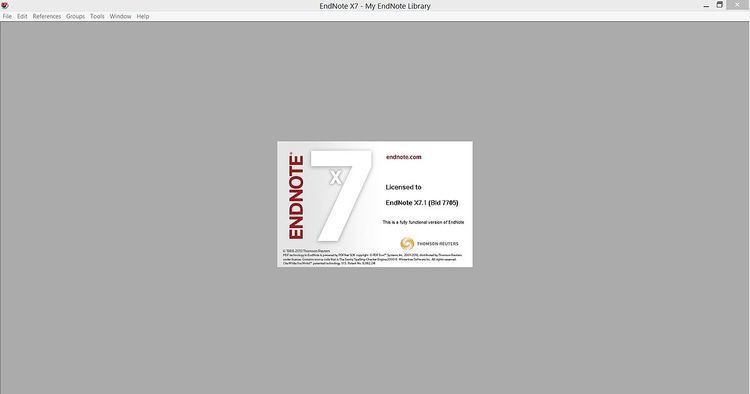Preview release 22334 License Proprietary | ||
 | ||
Stable release X8 / November 10, 2016; 3 months ago (2016-11-10) Operating system | ||
EndNote is a commercial reference management software package, used to manage bibliographies and references when writing essays and articles. It is produced by Clarivate Analytics (previously Thomson Reuters).
Contents
Features
EndNote groups citations into "libraries" with the file extension *.enl and a corresponding *.data folder.
There are several ways to add a reference to a library: manually, or by exporting, importing, copying from another EndNote library, or connecting from EndNote. The program presents the user with a window containing a dropdown menu from which to select the type of reference they require (e.g., book, congressional legislation, film, newspaper article, etc.), and fields ranging from the general (author, title, year) to those specific to the kind of reference (abstract, author, ISBN, running time, etc.)
Most bibliographic databases allow users to export references to their EndNote libraries. This enables the user to select multiple citations and saves the user from having to manually enter the citation information and the abstracts. Some databases (e.g., PubMed) requires the user to select citations, select a specific format, and save them as .txt files. The user can then import the citations into the EndNote software. It is also possible to search library catalogs and free databases, such as PubMed, from within the EndNote software program itself.
If the user fills out the necessary fields, EndNote can automatically format the citation into any of over 2,000 different styles the user chooses. For example, listed below are some citations from Gray's Anatomy using several different styles:
In Windows, EndNote creates a file with an *.enl extension, along with a *.data folder containing various MySQL files with *.myi and *.myd extensions. EndNote can be installed so that its features, like Cite While You WriteTM, appear in the Tools menu of Microsoft Word and OpenOffice.org Writer.
EndNote can export citation libraries as HTML, plain text, Rich Text Format, or XML. From version X.7.2, one library can be shared with up to 14 other EndNote users. The data is synchronized via the EndNote cloud service, with everybody having full write access to the library.
EndNote can also organize PDFs on the user's hard drive (or full text on the web) through links to files or by inserting copies of PDFs. It is also possible to save a single image, document, Excel spreadsheet, or other file type to each reference in an EndNote library. Starting from EndNote X version 1.0.1, formatting support for OpenDocument files (ODT) using the Format Paper command is supported.
Legal dispute with Zotero
In September 2008, Thomson Reuters, the owners of EndNote, sued the Commonwealth of Virginia for US$10 million and requested an injunction against competing reference management software. George Mason University's Center for History and New Media had developed Zotero, a free/open source extension to Mozilla Firefox. Thomson Reuters alleges that the Zotero developers reverse engineered and/or decompiled EndNote, that Zotero can transform proprietary EndNote citation style files (.ens) to the open Citation Style Language format, that they host files converted in this manner, and that they abuse the "EndNote" trademark in describing this feature. Thomson Reuters claims that this is violation of the site license agreement. They also added a restrictive click-thru license to their styles download web site. George Mason University responded that it would not renew its site license for EndNote, that "anything created by users of Zotero belongs to those users, and that it should be as easy as possible for Zotero users to move to and from the software as they wish, without friction." The journal Nature editorialized that "the virtues of interoperability and easy data-sharing among researchers are worth restating. Imagine if Microsoft Word or Excel files could be opened and saved only in these proprietary formats, for example. It would be impossible for OpenOffice and other such software to read and save these files using open standards — as they can legally do." The case was dismissed on June 4, 2009.
EndNote Web
EndNote Web, a web-based implementation of EndNote, offers integration with the ISI Web of Knowledge.
Example
The following example shows two records ready for import as a text file. Such files normally use the file extension .enw.
%0 Book%A Geoffrey Chaucer%D 1957%T The Works of Geoffrey Chaucer%E F.%I Houghton%C Boston%N 2nd%0 Journal Article%A Herbert H. Clark%D 1982%T Hearers and Speech Acts%B Language%V 58%P 332-373%0 Thesis%A Cantucci, Elena%T Permian strata in South-East Asia%D 1990%I University of California, Berkeley%9 DissertationTags and fields
The left table is a list of EndNote tags and their associated field names. The right table is a list of standard reference types for the %0 field. Compare this scheme with the much older refer scheme which uses a similar syntax. Entire records as separated by a single blank line.
Version history and compatibility
Niles and Associates produced early versions of EndNote.
